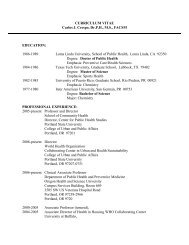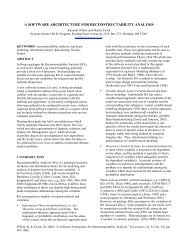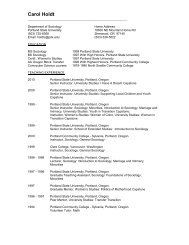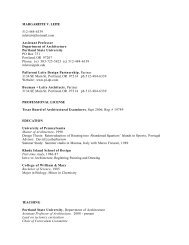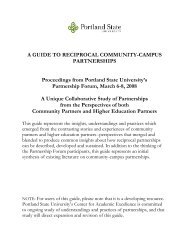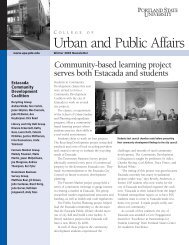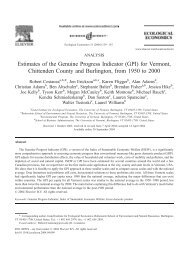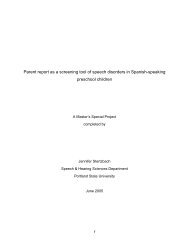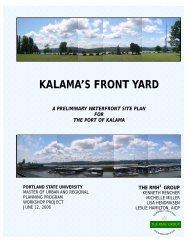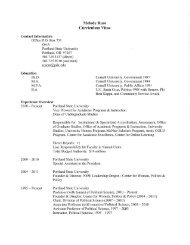Effects of integral stimulation therapy on speech - Portland State ...
Effects of integral stimulation therapy on speech - Portland State ...
Effects of integral stimulation therapy on speech - Portland State ...
You also want an ePaper? Increase the reach of your titles
YUMPU automatically turns print PDFs into web optimized ePapers that Google loves.
neuromuscular impairment (Caruso & Strand, 1999; Crary, 1993; ASHA, 2007). The vast<br />
majority <str<strong>on</strong>g>of</str<strong>on</strong>g> research for treatment <str<strong>on</strong>g>of</str<strong>on</strong>g> apraxia has been c<strong>on</strong>ducted <strong>on</strong> adults with acquired<br />
apraxia <str<strong>on</strong>g>of</str<strong>on</strong>g> <strong>speech</strong> (Chumpelik, 1984; Freed, Marshall & Frazier, 1997; Rosenbek, 1985;<br />
Rosenbek, Lemme, Ahern, Harris, & Wertz, 1973; Square, Chumpelik, Morningstar, &<br />
Adams, 1986; Wambaugh, Kalinyak-Fliszar, West, & Doyle, 1998). Am<strong>on</strong>g these<br />
approaches claiming beneficial effects for adults with AOS, several have indicated<br />
positive results when used as treatment methods for CAS. Treatment research employing<br />
multiple modalities <str<strong>on</strong>g>of</str<strong>on</strong>g> visual, auditory, and tactile feedback, such as Chumpelik and<br />
Sherman’s studies <str<strong>on</strong>g>of</str<strong>on</strong>g> Prompts for Restructuring Oral Muscular Ph<strong>on</strong>etic Targets (1983),<br />
Edeal’s study <str<strong>on</strong>g>of</str<strong>on</strong>g> frequency <str<strong>on</strong>g>of</str<strong>on</strong>g> motor practice (2008), Jakielski et al’s., (2006), and Strand<br />
and Debertine’s study <str<strong>on</strong>g>of</str<strong>on</strong>g> <str<strong>on</strong>g>integral</str<strong>on</strong>g> <str<strong>on</strong>g>stimulati<strong>on</strong></str<strong>on</strong>g> (2000) have all cited increased intelligibility<br />
for children diagnosed with childhood apraxia <str<strong>on</strong>g>of</str<strong>on</strong>g> <strong>speech</strong>.<br />
Square highlights the most frequently used categories <str<strong>on</strong>g>of</str<strong>on</strong>g> treatment methods for<br />
CAS which include, “tactile-kinesthetic facilitati<strong>on</strong>, rhythmic and melodic facilitati<strong>on</strong>,<br />
and gestural cueing” (1999 p. 149). Am<strong>on</strong>g these treatment approaches is <str<strong>on</strong>g>integral</str<strong>on</strong>g><br />
<str<strong>on</strong>g>stimulati<strong>on</strong></str<strong>on</strong>g> <str<strong>on</strong>g>therapy</str<strong>on</strong>g> which utilizes combined elements <str<strong>on</strong>g>of</str<strong>on</strong>g> tactile, rhythmic, and melodic<br />
treatment approaches with the additi<strong>on</strong> <str<strong>on</strong>g>of</str<strong>on</strong>g> specific c<strong>on</strong>diti<strong>on</strong>s <str<strong>on</strong>g>of</str<strong>on</strong>g> practice c<strong>on</strong>sistent with<br />
principles <str<strong>on</strong>g>of</str<strong>on</strong>g> cognitive motor learning.<br />
Tactile-kinesthetic treatment techniques (Moto-Kinesthetic Speech Training and<br />
Prompts for Restructuring Oral Muscular Ph<strong>on</strong>etic Targets [PROMPT]) attempt to help<br />
children with CAS obtain better oral movement c<strong>on</strong>trol by direct motor manipulati<strong>on</strong> <str<strong>on</strong>g>of</str<strong>on</strong>g><br />
the structures used for <strong>speech</strong> and tactile cues directed at appropriate locati<strong>on</strong>s (Bose &<br />
Square, 2001; Chumpelik, 1984). PROMPT seeks to facilitate oral-verbal feedback for<br />
12



